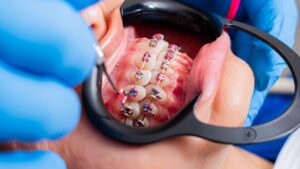Invisalign offers a nearly invisible way to straighten teeth without traditional metal braces. While the aligners alone can handle most cases, some treatments need extra support. This is where Invisalign attachments come in. These small, tooth-colored shapes help aligners apply the right amount of pressure in the right spots.
What Are Invisalign Attachments?

Invisalign attachments are tiny composite shapes bonded to the teeth. They blend with natural tooth color, making them barely noticeable. Unlike traditional brackets, they don’t involve metal or wires. Dentists place them in precise locations to help the aligners grip and move teeth more effectively.
Why Are Attachments Necessary?
Aligners alone can move teeth in simple cases. Some movements, like rotations or vertical shifts, need extra force. Attachments provide that added pressure. They also help with:
- Moving stubborn teeth that resist shifting
- Correcting bite issues
- Aligning small or oddly shaped teeth
- Preventing aligners from slipping out of place
Without attachments, some treatments would take much longer or might not work at all.
How Attachments Work with Invisalign
Attachments act as anchor points for the aligners, giving them a better grip on the teeth. Unlike regular aligners that rely on surface contact, attachments provide specific areas for the aligners to push against. This added control makes it possible to move teeth in directions that aligners alone might struggle with.
How Attachments Improve Tooth Movement
Attachments help aligners perform more complex movements, including:
- Applying More Precise Pressure – The aligners exert force against the attachments, allowing for targeted tooth movement. This makes it easier to rotate, shift, or tilt teeth that might not respond as well to regular aligners.
- Enhancing Fit and Stability – Aligners with attachments fit more snugly, reducing the risk of them slipping or feeling loose. This is especially helpful for patients who need to wear their aligners for 20–22 hours a day.
- Allowing Multi-Directional Movement – Traditional aligners often focus on forward and backward movement, but attachments make it possible to move teeth up, down, or even diagonally.
- Speeding Up Treatment Time – Because attachments help aligners work more efficiently, they can reduce overall treatment time in some cases.
How Long Do Patients Need Attachments?
The length of time a patient needs attachments depends on their treatment plan. Some people wear them for the entire duration of Invisalign treatment, while others may only need them for a portion of it. If a
dentist determines that attachments are no longer necessary, they can remove them before treatment ends.
In some cases, patients may need refinements, which are additional adjustments made to fine-tune results. This may involve repositioning attachments or adding new ones to improve the final alignment
Types of Tooth Movements That Need Attachments
Some teeth are harder to move than others. Attachments make it easier to:
Rotate Canines and Premolars
These teeth have rounded surfaces, making it difficult for aligners to grip them properly. Attachments provide a surface that helps turn them.
Move Teeth Up or Down
Aligners alone struggle with vertical movement. Attachments help lift or push teeth into place.
Shift Teeth Sideways
Some cases need teeth to shift sideways rather than forward or back. Attachments offer better control for these movements.
Correct Bite Issues
Deep bites, open bites, and crossbites sometimes need attachments for better alignment.
How Dentists Place Invisalign Attachments
Placing attachments is a quick and painless process. Here’s how it works:
- The dentist cleans and dries the tooth surface.
- A special bonding agent is applied.
- A small amount of composite material is placed in the correct spot.
- A curing light hardens the material.
- The dentist polishes the attachment to smooth out any rough edges.
Once the treatment is complete, attachments are removed with a polishing tool. They don’t damage the enamel or leave marks.
Caring for Teeth with Attachments
Attachments require extra care to keep them clean and effective. Here’s what helps:
- Brush thoroughly – Attachments can trap food, so proper brushing prevents buildup.
- Floss daily – Food particles can get stuck around the attachments. Flossing keeps teeth and gums healthy.
- Use a water flosser – This helps clean hard-to-reach spots around attachments.
- Avoid staining foods and drinks – Coffee, tea, and wine can discolor attachments over time.
Do Attachments Affect How Aligners Feel?
Attachments can make aligners feel tighter, especially in the beginning. Some people experience slight discomfort for the first few days. Once the teeth adjust, the feeling becomes less noticeable. Attachments also make aligners fit more snugly, reducing the risk of slipping.
Do All Invisalign Patients Need Attachments?
Not everyone needs attachments. Simple cases involving minor shifts might not require them. The dentist decides based on the treatment plan. Some people need attachments on several teeth, while others may need just one or two.
Can Attachments Fall Off?
Attachments rarely fall off, but it can happen. Eating sticky or hard foods increases the risk. If an attachment comes loose, visiting the dentist as soon as possible helps keep the treatment on track.
What Happens When Invisalign Treatment Ends?
Once the treatment is complete, the dentist removes the attachments and polishes the teeth. The teeth may feel slightly different for a day or two. Afterward, most people wear retainers to maintain their new smile.
Final Thoughts
Invisalign attachments help aligners move teeth more efficiently. They provide the extra force needed for certain movements, making treatment more precise. Keeping attachments clean and following the dentist’s advice makes the process smoother. With proper care, Invisalign can deliver a straighter smile without the hassle of traditional braces. Contact Us for more details and expert guidance at Ortho Inc.





